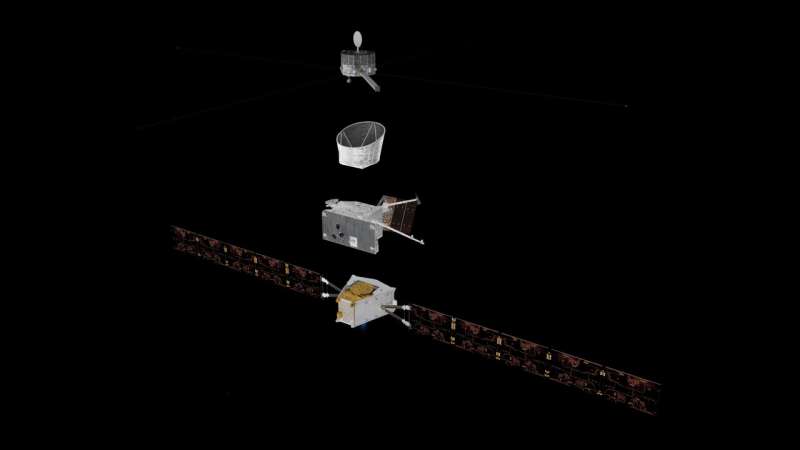This article has been reviewed according to Science X's editorial process and policies. Editors have highlighted the following attributes while ensuring the content's credibility:
fact-checked
trusted source
proofread
Glitch on BepiColombo: Work ongoing to restore spacecraft to full thrust

BepiColombo, the joint ESA/JAXA mission to Mercury, has experienced an issue that is preventing the spacecraft's thrusters from operating at full power.
BepiColombo is a three-part spacecraft consisting of two scientific probes and the Mercury Transfer Module, which are designed to separate from one another as part of the mission's Mercury orbit insertion operations.
The solar arrays and electric propulsion system on the Mercury Transfer Module are used to generate thrust during the spacecraft's complex journey from Earth to Mercury.
However, on 26 April, as BepiColombo was scheduled to begin its next maneuver, the Transfer Module failed to deliver enough electrical power to the spacecraft's thrusters.
A combined team from ESA and the mission's industrial partners set to work the moment the issue was identified. By 7 May, they had restored BepiColombo's thrust to approximately 90% of its previous level. However, the Transfer Module's available power is still lower than it should be, and so full thrust cannot yet be restored.
The team's current priorities are to maintain stable spacecraft propulsion at the current power level and to estimate how this will affect upcoming maneuvers. Work continues in parallel to identify the root cause of the issue and to maximize the power available to the thrusters.
The BepiColombo Flight Control Team working at ESA's ESOC mission control center in Darmstadt, Germany, has arranged additional ground station passes in order to closely monitor the spacecraft and react rapidly if needed.
If the current power level is maintained, BepiColombo should arrive at Mercury in time for its fourth gravity assist at the planet in September this year. Final orbit insertion at Mercury is scheduled for December 2025 and the start of routine science operations for Spring 2026.
Updates will be shared as new information becomes available.
BepiColombo is a joint mission between ESA and the Japan Aerospace Exploration Agency (JAXA) to Mercury, the least explored planet of the inner solar system.
The mission features two scientific spacecraft, which will be inserted into different orbits around Mercury: ESA's Mercury Planetary Orbiter and JAXA's Mercury Magnetospheric Orbiter.
Both continue to perform excellently. Packed with scientific instruments, they are designed to study Mercury's composition, atmosphere, magnetosphere and history, and to address long-standing questions on the formation and evolution of our solar system.
Provided by European Space Agency





















